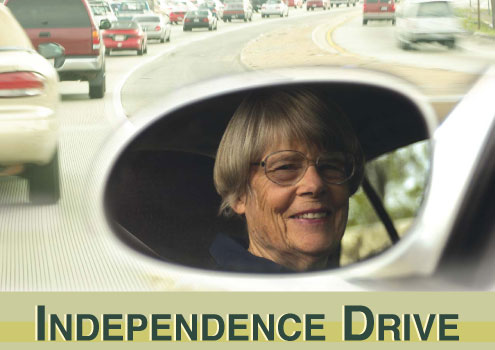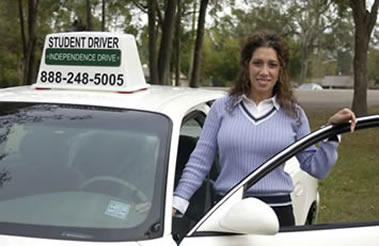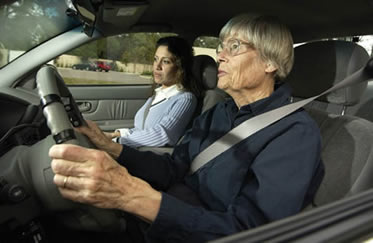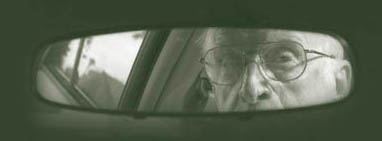
UF Program Helps Older Drivers Stay Safe
By Jill Pease
downloadable pdf
Priscilla Milliman considers herself an experienced driver. A Southern California native, she learned to drive as a teenager by navigating the Los Angeles-area freeways. For most of her life she has driven in urban areas and in Europe, where she and her husband lived for many years.
But at 75, Milliman, of Gainesville, had been reluctant to drive outside of the city limits, feeling insecure on the interstate and in heavy traffic. And as an avid tennis player, she also recognized that her physical reaction time had slowed in recent years.
So she turned to the University of Florida National Older Driver Research and Training Center at the College of Public Health and Health Professions for help in making a decision about her driving abilities.
Introduced in 2003, the National Older Driver Research and Training Center is supported by $1.6 million in funding from the Centers for Disease Control and Prevention and the Federal Highway Administration. It is the nation’s leading research and service center dedicated exclusively to older drivers.
Directed by William Mann, chair of the college’s Department of Occupational Therapy, the center aims to enable seniors to remain independent within the community by prolonging safe driving abilities and, for those unable to continue driving safely, the center offers alternatives to driving for obtaining goods and services.
Center researchers are also working to determine which methods are best for evaluating seniors’ driving abilities and to determine if roadway design features might affect safe driving performance. The data are being gathered from the center’s assessment programs in Gainesville and Ocala, as well as collaborating sites in Jacksonville and Orlando.
“We must better understand how to assess driving performance as America’s population ages,” Mann says. “Not only are the numbers and proportion of older Americans increasing, but a greater proportion of seniors continue to drive, and the incidence of injury and fatality resulting from motor vehicle crashes involving seniors continues to grow at a rate faster than that of the overall population.
“Research indicates that older drivers are overrepresented in crashes at intersections and that older driver safety problems are concentrated among seniors who are either unaware of their difficulties or unable to make compensating adjustments to their driving,” he adds.
In the last decade, the number of licensed drivers over the age of 70 rose 39 percent, to more than 18 million, according to the National Highway Traffic Safety Administration. And by 2024, an estimated one in four drivers will be 65 or older.
Vision problems, cognitive deficits, physical limitations and even some medications can contribute to difficulty driving as people age.
The center’s assessment program, Independence Drive, offers two-hour evaluations that include physical and cognitive testing and assessments of on-road driving skills. For those who are found to be unsafe drivers, the driver rehabilitation specialist offers additional services, such as training and/or the use of equipment to enable a person to drive safely, and counseling on transportation alternatives.
“Our driving evaluation is comprehensive because we look at the entire person,” says Desiree Lanford, a licensed occupational therapist who specializes in driving rehabilitation. “Getting older does not necessarily mean that an individual will be a worse driver. It all depends on a person’s physical and cognitive status. Our goal is to keep older drivers safely on the road for as long as possible by forming a holistic view of the person and his or her environment.”

Desiree Lanford is a licensed occupational therapist who specializes in driving rehabilitation.
Milliman’s assessment by Lanford demonstrated that she is a safe driver, but the results confirmed Milliman’s suspicion that she was too cautious in her driving at times. Milliman scheduled a training session with Lanford to brush up on some driving tips, which included how closely she should follow the car in front of her and how to use mirrors and scan the road so that she is fully aware of the environment.
“It made me realize that my observation powers were not that good,” Milliman says. “Desiree would ask me ‘what did you see on the sidewalk?’ I realized that I don’t really observe the whole picture. She told me that scanning the area is a form of driving defensively so that in case a child or dog runs out onto the street there is more time to react.”
The assessment and training have helped Milliman feel more secure in her driving skills and given her hope that as a socially active senior who loves to travel she can return to driving on the interstate.
“I feel like I’m a better driver than I thought I was and that gives me more confidence,” she says. “My goal is to drive to Jacksonville International Airport and St. Augustine with confidence. This would be an achievement for me.”

Desiree Lanford and Priscilla Milliman
Milliman is among a group of Florida seniors whose assessment experiences are contributing to the center’s research that will hopefully aid older drivers all over the country who are facing decisions about their driving capabilities.
The center’s research activities kicked off with a conference in 2003 convening the world’s experts in driving assessment to determine the “state of the science” and identify areas of research the center would explore.
Several major research projects are now in the works. The first examines problematic roadway conditions — such as intersections, interchanges and construction zones — and their effect on older drivers. The second will help determine which clinically administered tests can accurately predict older drivers’ on-road performance, filling the need for a reliable, standardized method that can be used by driving specialists nationwide. The third compares younger and older drivers in a high-quality driving simulator, which mimics real road conditions. And a fourth project examines the ability of physicians to help their patients stay safe on the road.
“Our research is expected to find out how accurate common paper-pencil tests are at predicting driving performance in older drivers,” says Dennis McCarthy, the center’s co-director. “We have a 180-degree field-of-view simulator that can be viewed from inside the cabin of a stationary compact car. Custom scenarios are being reproduced to replicate real-life situations and compare driving performance with behind-the-wheel driving skills.”
Armed with a career development grant from the Centers for Disease Control and Prevention, Sherrilene Classen, an assistant professor in the UF Department of Occupational Therapy, is developing a public health model for addressing the issue of safe elderly driving that will complement the center’s research agenda.
Widespread need for more trained experts in driving assessment is also being addressed. Fewer than 300 certified driving rehabilitation specialists are now working in the United States — not enough to meet the demands of a growing elderly driving population. In partnership with the American Occupational Therapy Association, the center is developing a model site for educating occupational therapists as driver safety intervention specialists.
The center’s research has particular significance in Florida where nearly 4 million residents are 60 years or older, 3 million of whom have driver’s licenses. More than 25 percent of Florida’s older drivers report some limitations in their driving or do not drive at all. The reasons they cite include health problems, financial limitations and difficulty driving long distances, in bad weather or at night. Yet only about 10 percent of older Floridians use public transportation, raising questions about the options available to those who can no longer drive but wish to remain independent.
George Price, 76, recently faced that predicament.
Following an assessment at Independence Drive, Lanford recommended that Price discontinue driving until he switched from his pickup truck to a smaller vehicle with automatic transmission, completed driver training with Lanford and fitted his new car with adaptive devices, such as a spinner knob, to make turning the steering wheel easier.
Physical problems, including a nerve disorder in his legs, had made maneuvering the large truck difficult for Price, and
Lanford didn’t feel he was safe to drive until the right adjustments were made.
“It upset me, of course, but I had to acknowledge that what she said was true,” says Price, a retired UF scientist.
Although Price, who lives on Lake Santa Fe, is content in his home surrounded by the books and music he loves, and has lots of friends to assist him with transportation needs, he recognizes that the idea of not driving is a difficult one to face.
In the meantime, he plans to get a different car and follow Lanford’s recommendations.
“There are places to go and people to see,” he says.
Through Independence Drive’s counseling services and referrals to alternative transportation, the center hopes to keep otherwise healthy, independent older adults on the road as long as possible and influence public policy in the development of transportation options for seniors.
“Loss of a driver’s license can have significant impact on a person’s life,” McCarthy says. “For those former drivers without financial resources or social supports, revocation of the driving privilege may result in the inability to live independently within the community,” he says, adding that the loss of a driver’s license may start a process that can lead to a senior needing to enter a nursing home or other care facility.
That’s a prospect that Philip Spear of Gainesville has been contemplating for some time. He and his wife have been working with a geriatric care manager to prepare for a time when he may no longer be able to drive to medical appointments, the grocery store and the pharmacy.
At 90, Spear has seen many friends struggle with the loss of a driver’s license when they weren’t prepared for such a life-changing event. He also remembers being forced to take the car keys away from his mother when she was no longer fit to drive.
With those personal experiences in mind, Spear decided to have a driving assessment at Independence Drive. While the results showed Spear is a safe driver, Lanford identified physical problems that hadn’t been previously diagnosed by his health-care providers.
“During the computer tests, there were several instances in which I had visual problems and in one set of tests, the results indicated that my two eyes weren’t working together,” Spear says.
A follow-up visit to an ophthalmologist confirmed the problem, and he was given a new eyeglass prescription. He also received physical therapy on his neck to improve flexibility when turning his head, another recommendation from Lanford.
“It was most reassuring when I was told I didn’t have deficiencies in my driving skills, because it’s scarcely imaginable how important it is for people in my age group to be able to drive,” Spear says. “My wife and I have been retired in Gainesville for nearly 25 years, living in the house we built, and we intend to stay here for the rest of our lives.
“I have told more than one of my friends about the assessment," he says. "It has given me considerable comfort and peace of mind and the reassurance that this life can continue the way it is for awhile.”
Desiree Lanford
Coordinator, Driver Rehabilitation
(352) 273-6057
dlanford@phhp.ufl.edu
William Mann
Director, National Older Driver Research and Training Center
(352) 273-6135
wmann@phhp.ufl.edu
Dennis McCarthy
Co-Director, National Older Driver Research and Training Center
(352) 273-6024
dmccarth@phhp.ufl.edu
Related Web site:
http://independencedrive.phhp.ufl

Older Driver Statistics
During 2002, 81 percent of traffic fatalities involving older drivers occurred during the day and 75 percent of the crashes involved another vehicle.
17 percent of older drivers’ crashes involved left turns. The oldest drivers show the greatest proportion of left-turn crashes—16 percent of 65-74 year-old drivers and 21 percent of drivers 75 or older.
About half of fatal crashes involving drivers 80 years and older occur at intersections and involve more than one vehicle. This compares with 23 percent of drivers up to age 50.
Between 1998 and 2003, the percentage of drivers 70 or older is expected to increase from 9 percent to almost 14 percent.
Older drivers are more than three times as likely to die in a wreck than younger drivers because of medical complications.
Sources: National Highway Traffic Safety Administration, Centers for Disease Control and Prevention, Federal Highway Administration.
|
